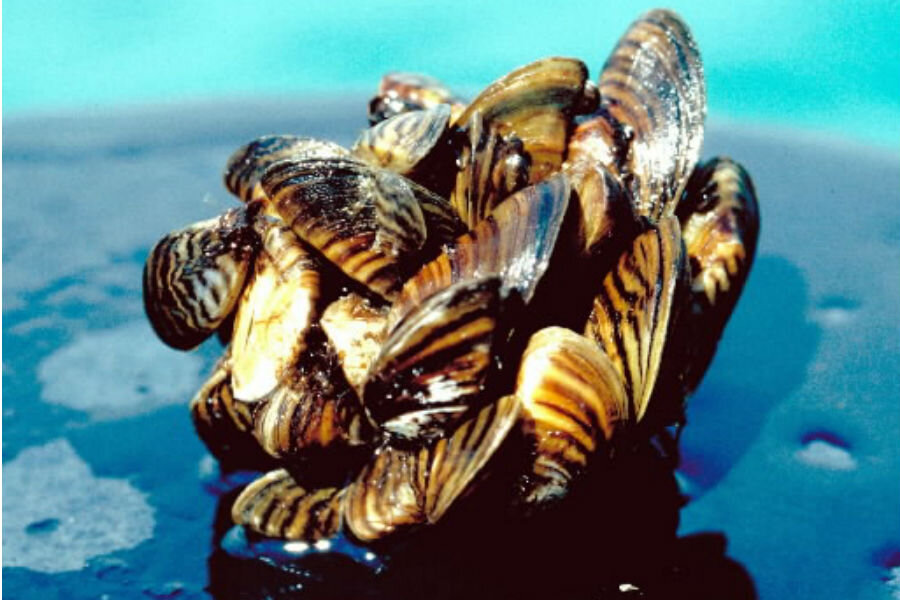How dogs sniff out invasive species of mussel in Montana
Loading...
Zebra and quagga mussels have cost the country billions of dollars, as officials have attempted to locate and eradicate the invasive species over the past three decades. After years of fighting their spread to bodies of water across the United States, Montana is trying a new strategy: releasing the hounds.
Like their bomb-sniffing and drug-sniffing counterparts, these dogs have been trained to pick out the scent of zebra and quagga mussels in an attempt to identify the creatures before they take hold in a new area. These environmental watchdogs are typically deployed to boat-inspection sites to make sure any ships entering their domain are not carrying these unwanted stowaways.
But after scientists detected mussel larvae in a Montana reservoir, three of these environmentalist dog teams have been shipped to other lakes in the state to check the shoreline to see if any more had slipped into the area. With these canines on the case, man's best friend might also be the environment's best friend as well.
Originally from Eastern Europe, zebra and quagga mussels are two very similar species of invasive freshwater mussel. According to the National Wildlife Federation, these tiny mussels were picked up in the ballast water of large seagoing ships that made their way into the Great Lakes in the 1980s. From there, they quickly spread to all the Great Lakes by the early 1990s, and have since taken advantage of natural rivers and artificial waterways to spread their geographical footprint by hitching rides on boats.
Like most invasive species, these mussels have no natural predators in the United States to slow their rapid increase in population size. A single mussel can produce five million eggs in its lifetime, and while only 100,000 make it to adulthood, this rapid reproduction has resulted in an estimated population of over 10 trillion zebra and quagga mussels in the Great Lakes alone. These mussels eat plankton, leaving less food for native fish, and their tendency to live in sharp bunches have ruined pipes and even many beaches, contributing to billions of dollars in damage every year.
So far, scientists have been unable to kill these mussels without harming other wildlife, which means that preventing an invasion is the only way to keep local bodies of water free of the creatures. And that's where the dogs in Montana come in.
"This collaboration is just all hands on deck — or all paws on deck," Cindy Sawchuk, whose 2-year-old conservation detection dog named Hilo came to Lake Tiber in Montana to help search for the mussels, told the Great Falls Tribune.
These dogs have been trained to detect adult mussels, since the larvae are microscopic. When they smell an adult mussel, they have been trained bark and indicate to their trainer the presence of the invasive species on the hull of a ship. This was the first time the canines had ever searched the shoreline for the invasive species.
"These dogs are accurate and efficient at boats," Ms. Sawchuk said. "This is like a new application of that skill."
As the dogs sniffed out the Tiber reservoir, there were a few moments where they seemed to indicate the presence of the mussels on a dock that had previously tested positive for the presence of larvae, but investigators weren't able to positively confirm the conclusion without first getting permission to take the dock apart.
"The dogs got excited a few times, but we weren't able to verify anything," Eileen Ryce, the fisheries division administrator for Montana Fish, Wildlife and Parks, told the Great Falls Tribune on Saturday. She indicated that they were working on getting permission to make a more thorough inspection of the dock.
If mussels have already been detected in the lake, it might already be too late to contain the problem for the Tiber. But the dog teams will continue to inspect other bodies of water to see the extent of the invasion, with the next round of sniffing going to Canyon Ferry Reservoir, which previous tests indicated "suspect" but ultimately inconclusive results as to the presence of mussel larvae.
The dogs are only a small part of the effort in Montana to prevent the spread of the invasive species. Significant precautions have already been taken, including the banning of boating in Glacier Park until the source of the recent positive mussel tests is coming from.
"This is the first positive test in Montana for the larvae of quagga or zebra mussels," said Ms. Ryce in a statement. "Although we hoped we would never see these invasive species in Montana waters, we've been preparing for this possibility for some time, and we’re going to work together to address this threat."








